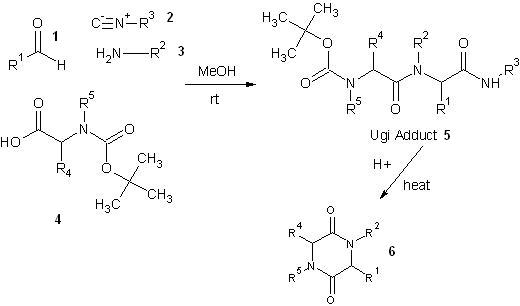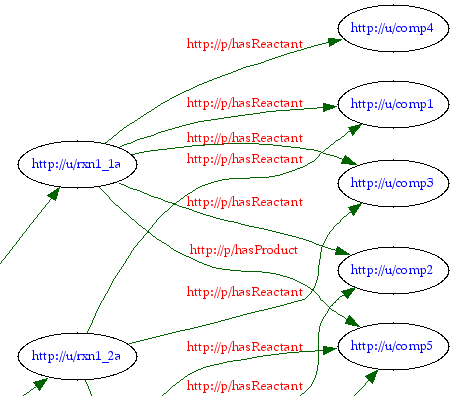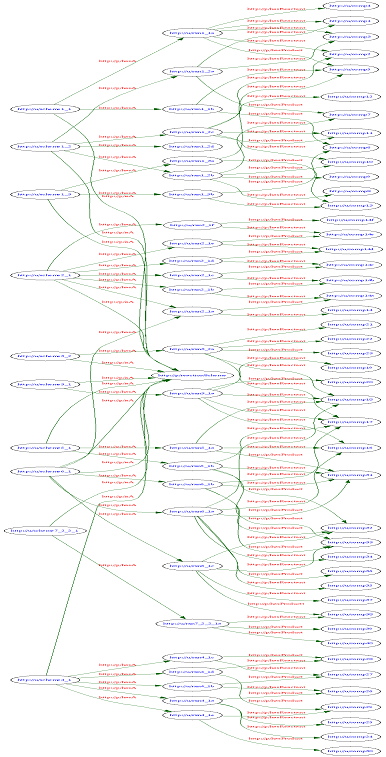I shall be using Alicia’s Open Science Thesis in Useful Chemistry as a technical demonstrator at ETD2007. I really want to show how a born digital thesis is a qualitative step forward. Completely new techniques can be used to structure, navigate and mine the information. Here’s a taster:
A chemical reaction diagram (“scheme”) is a graphic object which looks like this:

As you can see this is semantically useless. A lot of work has gone into this, but none of it is useful to a machine (look closely and you’ll see it’s a JPEG). Even in the native software which was used to draw it it is unlikely that the semantics can be easily determined. However XML and RDF allow a complete representation. It took me about 1 hour to handcraft the topology – if we had decent tools it would be seconds. The complete set of reaction schemes (I counted 11 in the thesis can be easily converted to a single RDF file which looks something like this:
uc:scheme1_1 pmr:isA pmr:reactionScheme .
uc:scheme1_1 pmr:hasA uc:rxn1_1a .
uc:scheme1_1 pmr:hasA uc:rxn1_1b .
uc:rxn1_1a pmr:hasReactant uc:comp1 .
uc:rxn1_1a pmr:hasReactant uc:comp2 .
uc:rxn1_1a pmr:hasReactant uc:comp3 .
uc:rxn1_1a pmr:hasReactant uc:comp4 .
uc:rxn1_1a pmr:hasProduct uc:comp5 .
uc:rxn1_1b pmr:hasReactant uc:comp5 .
uc:rxn1_1b pmr:hasProduct uc:comp6 .
(uc: refers to the usefulChemistry namespace, pmr: to mine).
There are many Open Source tools for graphing this and here is part of the output of one from the W3C

Here you can see that reaction1.1a has four reactants (compound 1,2,3,4) and 1 product (comp 5). Comp5 is the reactant for another reaction (clipped to save blog problems). The complete picture for the whole thesis looks like this:

and (assuming you have a large screen) you can see immediately what reactions every compound is involved in.
That’s only the start as it is possible to ask sophisticated questions from a SPARQL endpoint – and that’s where we are going next…
… IFF you make the theses true Open Access
-
Recent Posts
-
Recent Comments
- pm286 on ContentMine at IFLA2017: The future of Libraries and Scholarly Communications
- Hiperterminal on ContentMine at IFLA2017: The future of Libraries and Scholarly Communications
- Next steps for Text & Data Mining | Unlocking Research on Text and Data Mining: Overview
- Publishers prioritize “self-plagiarism” detection over allowing new discoveries | Alex Holcombe's blog on Text and Data Mining: Overview
- Kytriya on Let’s get rid of CC-NC and CC-ND NOW! It really matters
-
Archives
- June 2018
- April 2018
- September 2017
- August 2017
- July 2017
- November 2016
- July 2016
- May 2016
- April 2016
- December 2015
- November 2015
- September 2015
- May 2015
- April 2015
- January 2015
- December 2014
- November 2014
- September 2014
- August 2014
- July 2014
- June 2014
- May 2014
- April 2014
- March 2014
- February 2014
- January 2014
- December 2013
- November 2013
- October 2013
- September 2013
- August 2013
- July 2013
- May 2013
- April 2013
- March 2013
- February 2013
- January 2013
- December 2012
- November 2012
- October 2012
- September 2012
- August 2012
- July 2012
- June 2012
- May 2012
- April 2012
- March 2012
- February 2012
- January 2012
- December 2011
- November 2011
- October 2011
- September 2011
- August 2011
- July 2011
- May 2011
- April 2011
- March 2011
- February 2011
- January 2011
- December 2010
- November 2010
- October 2010
- September 2010
- August 2010
- July 2010
- June 2010
- May 2010
- April 2010
- August 2009
- July 2009
- June 2009
- May 2009
- April 2009
- March 2009
- August 2008
- July 2008
- June 2008
- May 2008
- April 2008
- March 2008
- February 2008
- January 2008
- December 2007
- November 2007
- October 2007
- September 2007
- August 2007
- July 2007
- June 2007
- May 2007
- April 2007
- December 2006
- November 2006
- October 2006
- September 2006
-
Categories
- "virtual communities"
- ahm2007
- berlin5
- blueobelisk
- chemistry
- crystaleye
- cyberscience
- data
- etd2007
- fun
- general
- idcc3
- jisc-theorem
- mkm2007
- nmr
- open issues
- open notebook science
- oscar
- programming for scientists
- publishing
- puzzles
- repositories
- scifoo
- semanticWeb
- theses
- Uncategorized
- www2007
- XML
- xtech2007
-
Meta
For some reasons I am a big fan of ‘graph mining’ 😉
Joerg
(1) Good – I’ll be showing some RDF tricks soon I hope
Pingback: Unilever Centre for Molecular Informatics, Cambridge - Staudinger’s Semantic Molecules » Blog Archive » Polymer Theses, Polymer Data and a Common Language.